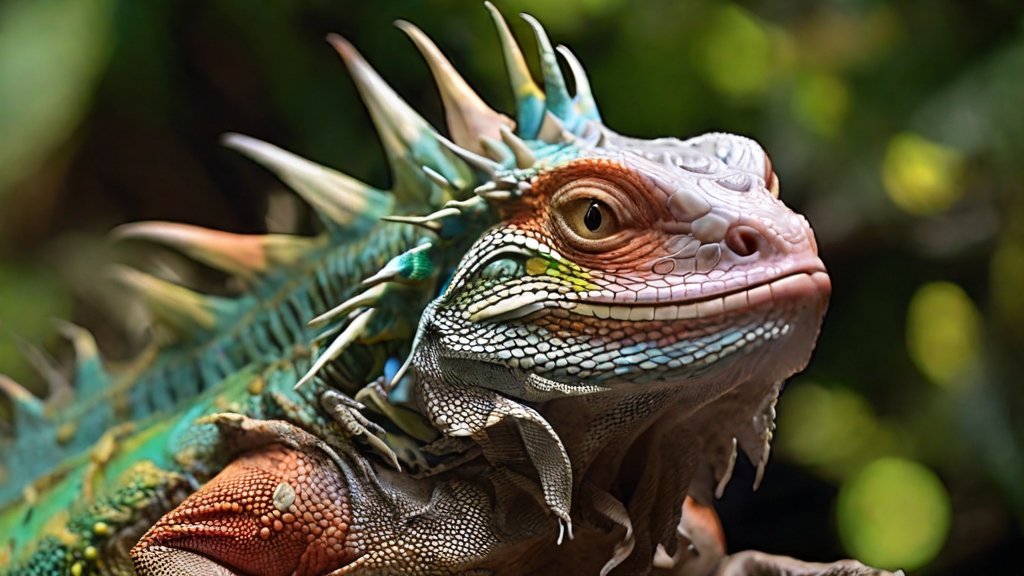Setting up an ideal environment for your pet iguana is crucial for their health and well-being. Iguanas are unique reptiles that require specific conditions to thrive. In this comprehensive guide, we will walk you through the process of creating the perfect iguana terrarium. From selecting the right enclosure to maintaining the ideal temperature and humidity levels, we’ll cover every aspect to ensure your iguana is happy and healthy.
Understanding Iguanas
Introduction to Iguanas
Before diving into the details of setting up the perfect iguana terrarium, it’s essential to understand what iguanas are. These fascinating reptiles belong to the family Iguanidae and are native to Central and South America. They come in various species, but the green iguana (Iguana iguana) is one of the most commonly kept as a pet.
Types of Pet Iguanas
When considering iguana ownership, it’s important to know that there are different types of pet iguanas. Some of the most popular choices include the green iguana, the lesser Antillean iguana, the blue iguana, and the rhinoceros iguana. Each type has its own unique characteristics and care requirements.
Iguana Behavior and Characteristics
Iguanas are known for their distinct behaviors and characteristics. They are herbivores, primarily feeding on leaves, fruits, and flowers. These reptiles are also known for their impressive climbing abilities, using their strong limbs and long tails to navigate trees and structures. Understanding their behavior is crucial for providing them with the right environment and care.
Legal Considerations
Before bringing an iguana into your home, it’s important to research and understand the legal regulations regarding iguana ownership in your area. Some species of iguanas may be protected or restricted due to conservation efforts or concerns about their potential impact on local ecosystems. Make sure you are in compliance with local laws and regulations.
Selecting the Right Enclosure
Choosing Between a Terrarium and an Outdoor Habitat
The first step in setting up the perfect iguana habitat is selecting the right enclosure. You have two main options: a terrarium or an outdoor habitat. The choice depends on your available space, climate, and personal preferences. Terrariums are suitable for indoor iguana keeping, while outdoor habitats mimic their natural environment.
Sizing Guidelines
Iguanas require spacious enclosures to thrive. The size of the enclosure will vary depending on the iguana’s age and size. As a general rule, the enclosure should be at least twice the length of the iguana, with enough vertical space for climbing. Young iguanas can start in smaller enclosures and then be moved to larger ones as they grow.
Materials for Enclosures
When constructing an iguana enclosure, consider the materials carefully. Plywood, glass, and PVC are common materials for indoor terrariums, while outdoor habitats may require more robust construction using wood and wire mesh. Ensure that the materials used are safe for your iguana and can withstand the necessary environmental conditions.
Ventilation and Lighting
Proper ventilation and lighting are essential for your iguana’s health. Iguanas need access to fresh air and natural sunlight or artificial UVB lighting for their metabolic processes. Terrariums should have screened lids or ventilation panels, while outdoor habitats should allow for exposure to natural sunlight.
Safety Measures
Iguanas are known for their climbing abilities, and they may attempt to escape if their enclosure is not secure. Make sure to install secure locks and screens to prevent any accidental escapes. Additionally, check for any potential hazards within the enclosure, such as sharp objects or toxic plants.
Creating the Ideal Habitat
Substrate Selection
Choosing the right substrate for the bottom of the terrarium is crucial. Newspaper, reptile carpet, or coconut coir are suitable options. Avoid using loose substrates like sand or gravel, as iguanas may accidentally ingest them while feeding.
Furnishing the Terrarium
To create a comfortable and stimulating environment for your iguana, you’ll need to furnish the terrarium with appropriate items.
Branches and Perches
Iguanas are arboreal creatures, so providing sturdy branches and perches for climbing is essential. Ensure that these structures are securely anchored to prevent accidents.
Hiding Spots
Iguanas appreciate having hiding spots within their enclosure where they can retreat to when they feel stressed or simply want some privacy. Use hollow logs or commercially available hides for this purpose.
Plants and Decorations
Adding live or artificial plants and decorations can enhance the aesthetics of the terrarium and provide enrichment for your iguana. Ensure that any live plants are non-toxic to iguanas.
Setting Up a Water Source
Iguanas need access to fresh water at all times. Provide a shallow water dish that is easy for them to access and clean it regularly to prevent contamination.
Temperature and Humidity Control
Maintaining the right temperature and humidity levels is crucial for your iguana’s well-being.
Temperature
Iguanas thrive in warm temperatures. The basking area should reach around 95°F (35°C), while the cooler end of the enclosure should be around 75°F (24°C) during the day. Nighttime temperatures can drop slightly.
Humidity
Iguanas require a humid environment, with humidity levels around 60% to 70%. You can achieve this by misting the enclosure with water regularly and using a hygrometer to monitor humidity levels.
Nutrition and Feeding
Iguana Diet
Providing the right diet is essential for your iguana’s health.
Types of Food
Iguanas are herbivores, and their diet should consist primarily of dark, leafy greens, vegetables, and fruits. Avoid feeding them high-protein or high-fat foods, as these can lead to health issues.
Feeding Schedule
Establish a regular feeding schedule for your iguana, and provide fresh food daily. Young iguanas may require more frequent feeding than adults.
Supplement Requirements
To ensure your iguana receives all the necessary nutrients, consider dusting their food with a calcium supplement and providing a UVB source for proper calcium absorption.
Water Requirements
In addition to their diet, iguanas need access to clean, fresh water at all times. Ensure that the water dish is large enough for them to soak in, as they may also use it for hydration and maintaining proper skin shedding.
Health and Hygiene
Common Health Issues in Iguanas
Iguanas are susceptible to several health issues, including metabolic bone disease, respiratory infections, and parasites. Familiarize yourself with common health problems so you can detect them early and seek veterinary care if necessary.
Signs of a Healthy Iguana
A healthy iguana should display certain characteristics, including bright and alert eyes, clear skin, and an active demeanor. Monitor your iguana’s behavior and appearance regularly to ensure they remain healthy.
Cleaning and
Maintaining a clean environment is vital for your iguana’s health and well-being.
Cleaning Schedule
Establish a regular cleaning schedule for the enclosure. Remove waste, uneaten food, and clean surfaces to prevent the growth of harmful bacteria.
Dealing with Waste
Dispose of waste materials properly and maintain good hygiene practices when cleaning the enclosure to protect both your iguana and yourself.
Veterinary Care
Regular veterinary check-ups are essential for your iguana’s health. Find a veterinarian experienced in reptile care and schedule routine visits to address any health concerns or questions you may have.
Handling and Socialization
Iguana Temperament
Understanding your iguana’s temperament is essential when it comes to handling and socialization. While some iguanas may tolerate handling, others may be more skittish or aggressive. Respect your iguana’s boundaries and approach them gently.
Handling Techniques
If you wish to handle your iguana, start with short sessions to allow them to become accustomed to your presence. Handle them gently and support their body to prevent stress or injury.
Socializing Your Iguana
Iguanas can become more comfortable with human interaction through positive experiences and consistent handling. Gradually increase the duration and frequency of handling sessions to build trust.
Recognizing Stress Signs
It’s essential to recognize signs of stress in your iguana, such as puffing up, hissing, or changing color. If you notice stress signs during handling, return your iguana to its enclosure to allow it to calm down.
Breeding Iguanas
Breeding Considerations
Breeding iguanas should only be undertaken by experienced reptile enthusiasts. It requires careful planning and knowledge of the specific requirements of the chosen iguana species.
Mating Behavior
Iguanas exhibit specific mating behaviors, including territorial displays and courtship rituals. Observing these behaviors can indicate that your iguanas are ready to breed.
Incubation and Hatching
If successful, the female iguana will lay eggs that require proper incubation. Understanding the incubation process and caring for the hatchlings is essential to their survival.
Legal and Ethical Considerations
Legal Restrictions
Iguana ownership may be subject to legal restrictions and regulations in your region. Ensure that you are aware of and comply with all applicable laws to avoid legal issues.
Ethical Iguana Ownership
Responsible iguana ownership includes providing proper care, habitat, and nutrition. Ethical considerations should guide your actions as a pet owner to ensure the well-being of your iguana.
Conservation Efforts
Some species of iguanas are endangered or threatened in the wild. Consider supporting conservation efforts and avoiding the purchase of wild-caught iguanas, as this contributes to their decline in natural habitats.
Frequently Asked Questions (FAQs)
A. Can Iguanas Be Kept as Pets?
Yes, iguanas can be kept as pets, but they require specific care and a commitment to their well-being.
B. Do Iguanas Require Specialized Care?
Iguanas have unique care requirements due to their dietary, environmental, and social needs. Proper care is essential for their health and longevity.
C. What Are the Costs Associated with Owning an Iguana?
The costs of owning an iguana include the initial setup of the enclosure, ongoing expenses for food and utilities, and potential veterinary care.
D. Are Iguanas Dangerous?
Iguanas are not inherently dangerous, but they can become aggressive if they feel threatened. Handling them with care and respect is essential to prevent bites or scratches.
E. How Long Do Iguanas Live in Captivity?
With proper care, iguanas can live for 15 to 20 years or even longer in captivity. Providing a suitable habitat and diet is crucial to their longevity.
Conclusion
In conclusion, creating the perfect iguana terrarium is a rewarding endeavor that requires careful planning and dedication. By understanding your pet’s needs and following the guidelines provided in this comprehensive guide, you can ensure that your iguana enjoys a happy and healthy life in captivity.




